

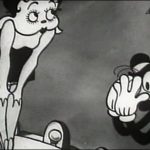

In the 1930 cartoon Dizzy Dishes, legendary and pioneering animator Grim Natwick working at Fleischer Studios, took an anthropomorphic dog character, added female legs, and gave her a hairdo inspired by Helen Kane, a popular singer of the time. In doing this, Natwick became the first person to draw a character that would eventually become known as Betty Boop.
One of the most famous and enduring animated characters of all time made what many consider to be her debut ninety-five years ago this month in Max Fleischer’s “Talkartoon,” Dizzy Dishes. Betty looked quite different back then in this prototypical version and would evolve over the next several cartoons.
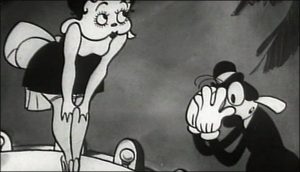 In a distinctly Fleischer anthropomorphic world, Dizzy Dishes (directed by Dave Fleischer) opens in a nightclub, where patrons are watching “flapper” cats dance on stage. The short then focuses on the character of Bimbo, a dog character and another Fleischer Studio player, also seen here in an early form that would change.
In a distinctly Fleischer anthropomorphic world, Dizzy Dishes (directed by Dave Fleischer) opens in a nightclub, where patrons are watching “flapper” cats dance on stage. The short then focuses on the character of Bimbo, a dog character and another Fleischer Studio player, also seen here in an early form that would change.
Bimbo (voiced by actor Billy Murray) is the overwhelmed and overworked chef in the nightclub, and he is trying to prepare a roast duck meal for an impatient Gorilla customer (William Costello).
It’s when Bimbo is bringing the meal to this customer that he encounters Betty singing “I Have to Have You” on stage. It’s in this song that Betty sings what would become her iconic “Boop-Oop-a-Doop!” line.
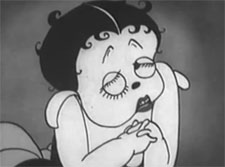 Bimbo is so taken that he joins in the act, making the Gorilla even more disgruntled. He grows so frustrated that he puts the utensils and plates together to form a makeshift sandwich and eats it. Bimbo and the roast duck both join in with the cats and dance on stage.
Bimbo is so taken that he joins in the act, making the Gorilla even more disgruntled. He grows so frustrated that he puts the utensils and plates together to form a makeshift sandwich and eats it. Bimbo and the roast duck both join in with the cats and dance on stage.
He winds up being a hit and is met with applause from the audience, but more frustration from the Gorilla, who proceeds to eat the table, and then chases Bimbo into the kitchen, where he demands his roast duck.
Bimbo tries desperately to throw together anything and proceeds to chop up almost everything in the kitchen, which then transforms into a model train that Bimbo rides out of the kitchen by crashing through the wall, at the conclusion.
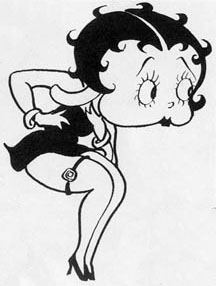 Dizzy Dishes, from beginning to end, is very “Fleischer-esque,” with fluid animation provided by Natwick and Ted Sears, that creates a short that seems in constant motion (Bimbo’s flailing body as he serves customers and prepares the food is of particular note).
Dizzy Dishes, from beginning to end, is very “Fleischer-esque,” with fluid animation provided by Natwick and Ted Sears, that creates a short that seems in constant motion (Bimbo’s flailing body as he serves customers and prepares the food is of particular note).
Adding to this are well-choreographed gags, such as the waiters all placing their orders in rhyme, as they one by one poke their heads into the kitchen.
Although she truly only has a cameo in Dizzy Dishes, it’s easy to see why Betty connected with audiences. Her very expressive animation, coupled with Margie Hines’ vocal performance, is truly scene-stealing.
Interestingly, singer Helen Kane, (whose all-around persona, as well as hairdo, was the major inspiration for Betty), filed a lawsuit against Fleischer and Paramount Studios, claiming that they had appropriated her singing style, specifically the phrase “Boop-Oop-a-Doop.”
The Fleischers went on to win the case, proving that a singer named Baby Esther had used “Boop-Oop-a-Doop” before Kane.
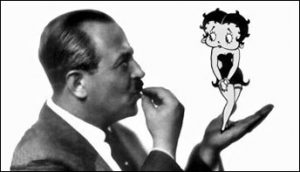 And, Betty went on to immense popularity. Her appearance developed over the years and through several other shorts, as she eventually dropped her floppy canine ears from Dizzy Dishes, transitioning into human form.
And, Betty went on to immense popularity. Her appearance developed over the years and through several other shorts, as she eventually dropped her floppy canine ears from Dizzy Dishes, transitioning into human form.
She became one of the Fleischers’ shining stars, appearing in ninety cartoon shorts from 1930 through 1939. Actress Mae Questel, known to many today as Aunt Bethany in National Lampoon’s Christmas Vacation (1989), began providing Betty’s voice in 1931. Margie Hines would return to voice Betty in 1938, when the Fleischers moved their Studio to Florida. Questel would then return to voice Betty through the years for various projects, including the character’s cameo in 1988’s Who Framed Roger Rabbit.
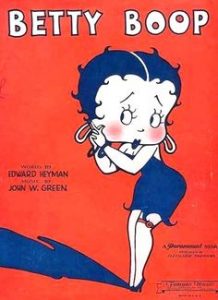 Betty’s appearance in that film, even though she hadn’t been in the spotlight for some time, showed just how popular she remained since her debut in 1930. There has been no shortage of Betty Boop merchandise throughout the years, and she has been a steadfast part of pop culture for over nine decades.
Betty’s appearance in that film, even though she hadn’t been in the spotlight for some time, showed just how popular she remained since her debut in 1930. There has been no shortage of Betty Boop merchandise throughout the years, and she has been a steadfast part of pop culture for over nine decades.
Earlier this year, the character was also the centerpiece of the popular Boop! The Musical, which opened on Broadway in March and went on to earn three Tony Award nominations, including one for actress Jasmine Amy Rogers, who portrayed Betty on stage.
Like so many characters, Betty Boop’s debut in Dizzy Dishes in 1930 may have been modest, but ninety-five years later, it’s easy to see that her continued impact on audiences and fans has deservedly made her one of the beloved icons of animation.
Happy Birthday, Betty!